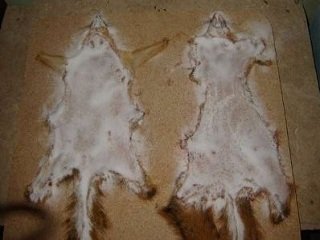 Recently, a friend of a friend decided to take up trapping. I had agreed to teach him how to take care of his furs. We had some difficulty meeting up so he had to take care of his first catch himself. He knew that he needed to salt the hides to stave off rot, but in doing so he ruined his furs. Taking care of furs or your trophy should be your top priority. You owe it to yourself and to your trophy to know how to properly care for your specimen. Learning how to appropriately use and apply salt to your cape/fur will help you prevent any potential rot problems.
Recently, a friend of a friend decided to take up trapping. I had agreed to teach him how to take care of his furs. We had some difficulty meeting up so he had to take care of his first catch himself. He knew that he needed to salt the hides to stave off rot, but in doing so he ruined his furs. Taking care of furs or your trophy should be your top priority. You owe it to yourself and to your trophy to know how to properly care for your specimen. Learning how to appropriately use and apply salt to your cape/fur will help you prevent any potential rot problems.
It is true that salt can be your best friend. When asked, “Where do you put the salt?’ world champion taxidermist, Joe Meder, replied, “Anywhere you want hair.” Salt wicks away moisture, drying the hide. Since bacteria require warmth and moisture, the application of salt stops the bacterial action which causes the hair to ‘slip’ or fall out. However, there is a right and wrong way to salt as my friend was to find out.
First, you will have to learn how to ‘turn’ and flesh. Most hunters/trappers think they know what fleshing means, and they are partially correct, but turning is a whole different world. It is easy to learn but hard to master. If you can talk a taxidermist into showing you the procedure first hand, you will be fine. If you want to learn yourself, then I suggest buying a DVD from a taxidermy supply company that will show you every step as often as you wish.
Obviously, fleshing means taking the meat off the cape; however, fine fleshing is what you want to learn. It is actually part of the turning process, and again, I suggest a DVD to help you learn. The two best DVDs on the market that can help you master this process are “How To”-Black Bear Hide Care with Joe “Kastaway” Kulis and Caping a Whitetail Deer with Lou Gagliano. These are awesome resources and you should have them in your hunting library.
It is important to remove all flesh before you salt. The salt will not preserve the skin under the meat; furthermore, it welds the meat to the skin. This is one big mistake my friend made. Since furbearers tend to have more delicate skin, it was almost impossible to remove the welded on flesh without making holes, and slippage was also evident.
When salting, you must salt every area of the hide. This includes rubbing salt in those hard to reach places like lips, eyelids and ears. Rub the salt in so it sticks. This was another error my friend made and it caused him to have unusable furs. Once the first salting has set for 24 hours, remove the damp salt and redo. After the second salting you can hang the hide to finish air drying.
I cannot stress how important it is to accurately turn, flesh and salt. Make sure salt covers every square millimeter of the skin. If a portion is not salted and dried, the hair will fall out.








